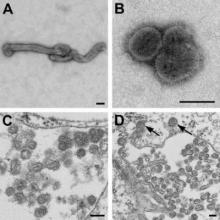User login
A newly recognized Thogotovirus species dubbed Bourbon virus has been linked to the death of a previously healthy man in Kansas, according to researchers at the Centers for Disease Control and Prevention.
“It is currently not known how many human infections and disease cases might be attributable to this novel pathogen. On the basis of limited information for our case-patient, health care providers might consider Bourbon virus as a potential infectious etiology in patients in whom fever, leukopenia, and thrombocytopenia develop without a more likely explanation and who have shown negative results for other tick-borne diseases (e.g., ehrlichiosis, anaplasmosis, or Heartland virus disease) or have not responded to doxycycline therapy,” Olga I. Kosoy and her fellow researchers at the CDC wrote (Emerg. Infect. Dis. 2015 May [doi:10.3201/eid2105.150150]).
The source case was a man who had a history of tick bite, fever, and fatigue and his lab findings included thrombocytopenia and leukopenia. He was given doxycycline for a presumed tick-borne illness, but his condition did not improve, and he died 11 days later from cardiopulmonary arrest with multiorgan failure.
The patient had been evaluated for a thorough list of potential pathogens. Eliminated potential causes included Rocky Mountain spotted fever, tularemia, Brucella, babesiosis, and Q fever. Also eliminated were a wide variety of fungal pathogens. Evaluations for Cytomegalovirus, Epstein-Barr virus, and Parvovirus showed past infection. Test results for hepatitis B and C viruses, West Nile virus, and HIV were negative. Blood, sputum, and urine bacterial cultures were negative.
At 9 days after the patient’s onset of illness, a whole blood specimen was sent to the CDC for Heartland virus testing. The analysis showed the presence of orthomyxoviral RNA that proved to be a novel Thogotovirus species, which the researchers proposed naming Bourbon virus for the Kansas county where the patient lived.
There have been reports of seven symptomatic human infections associated with Thogotovirus, but those case-patients had meningitis or encephalitis and did not have abnormalities in blood counts.
“The discovery of Bourbon virus, in addition to recent discoveries of tick-associated Heartland and severe fever with thrombocytopenia syndrome viruses, suggests that the public health burden of these pathogens has been underestimated,” the researcher wrote, adding that wider availability of improved methods of detecting pathogens is likely to result in similar discoveries in the future.
A newly recognized Thogotovirus species dubbed Bourbon virus has been linked to the death of a previously healthy man in Kansas, according to researchers at the Centers for Disease Control and Prevention.
“It is currently not known how many human infections and disease cases might be attributable to this novel pathogen. On the basis of limited information for our case-patient, health care providers might consider Bourbon virus as a potential infectious etiology in patients in whom fever, leukopenia, and thrombocytopenia develop without a more likely explanation and who have shown negative results for other tick-borne diseases (e.g., ehrlichiosis, anaplasmosis, or Heartland virus disease) or have not responded to doxycycline therapy,” Olga I. Kosoy and her fellow researchers at the CDC wrote (Emerg. Infect. Dis. 2015 May [doi:10.3201/eid2105.150150]).
The source case was a man who had a history of tick bite, fever, and fatigue and his lab findings included thrombocytopenia and leukopenia. He was given doxycycline for a presumed tick-borne illness, but his condition did not improve, and he died 11 days later from cardiopulmonary arrest with multiorgan failure.
The patient had been evaluated for a thorough list of potential pathogens. Eliminated potential causes included Rocky Mountain spotted fever, tularemia, Brucella, babesiosis, and Q fever. Also eliminated were a wide variety of fungal pathogens. Evaluations for Cytomegalovirus, Epstein-Barr virus, and Parvovirus showed past infection. Test results for hepatitis B and C viruses, West Nile virus, and HIV were negative. Blood, sputum, and urine bacterial cultures were negative.
At 9 days after the patient’s onset of illness, a whole blood specimen was sent to the CDC for Heartland virus testing. The analysis showed the presence of orthomyxoviral RNA that proved to be a novel Thogotovirus species, which the researchers proposed naming Bourbon virus for the Kansas county where the patient lived.
There have been reports of seven symptomatic human infections associated with Thogotovirus, but those case-patients had meningitis or encephalitis and did not have abnormalities in blood counts.
“The discovery of Bourbon virus, in addition to recent discoveries of tick-associated Heartland and severe fever with thrombocytopenia syndrome viruses, suggests that the public health burden of these pathogens has been underestimated,” the researcher wrote, adding that wider availability of improved methods of detecting pathogens is likely to result in similar discoveries in the future.
A newly recognized Thogotovirus species dubbed Bourbon virus has been linked to the death of a previously healthy man in Kansas, according to researchers at the Centers for Disease Control and Prevention.
“It is currently not known how many human infections and disease cases might be attributable to this novel pathogen. On the basis of limited information for our case-patient, health care providers might consider Bourbon virus as a potential infectious etiology in patients in whom fever, leukopenia, and thrombocytopenia develop without a more likely explanation and who have shown negative results for other tick-borne diseases (e.g., ehrlichiosis, anaplasmosis, or Heartland virus disease) or have not responded to doxycycline therapy,” Olga I. Kosoy and her fellow researchers at the CDC wrote (Emerg. Infect. Dis. 2015 May [doi:10.3201/eid2105.150150]).
The source case was a man who had a history of tick bite, fever, and fatigue and his lab findings included thrombocytopenia and leukopenia. He was given doxycycline for a presumed tick-borne illness, but his condition did not improve, and he died 11 days later from cardiopulmonary arrest with multiorgan failure.
The patient had been evaluated for a thorough list of potential pathogens. Eliminated potential causes included Rocky Mountain spotted fever, tularemia, Brucella, babesiosis, and Q fever. Also eliminated were a wide variety of fungal pathogens. Evaluations for Cytomegalovirus, Epstein-Barr virus, and Parvovirus showed past infection. Test results for hepatitis B and C viruses, West Nile virus, and HIV were negative. Blood, sputum, and urine bacterial cultures were negative.
At 9 days after the patient’s onset of illness, a whole blood specimen was sent to the CDC for Heartland virus testing. The analysis showed the presence of orthomyxoviral RNA that proved to be a novel Thogotovirus species, which the researchers proposed naming Bourbon virus for the Kansas county where the patient lived.
There have been reports of seven symptomatic human infections associated with Thogotovirus, but those case-patients had meningitis or encephalitis and did not have abnormalities in blood counts.
“The discovery of Bourbon virus, in addition to recent discoveries of tick-associated Heartland and severe fever with thrombocytopenia syndrome viruses, suggests that the public health burden of these pathogens has been underestimated,” the researcher wrote, adding that wider availability of improved methods of detecting pathogens is likely to result in similar discoveries in the future.
FROM EMERGING INFECTIOUS DISEASES

